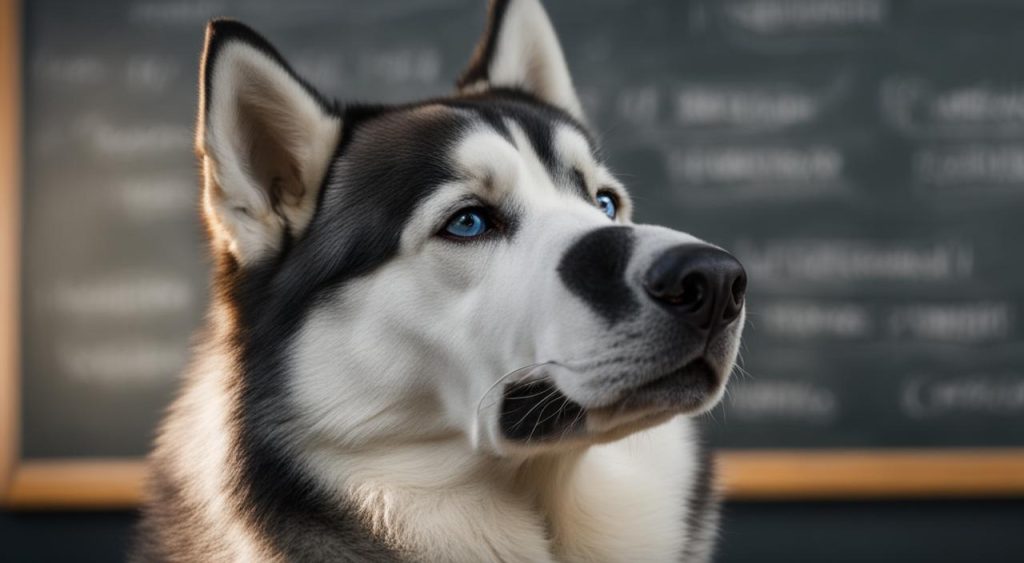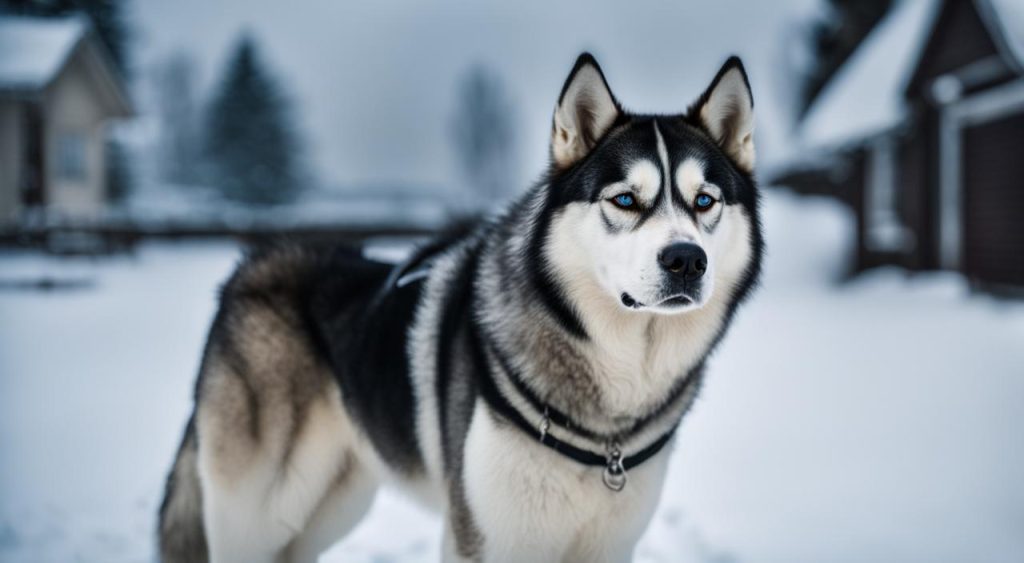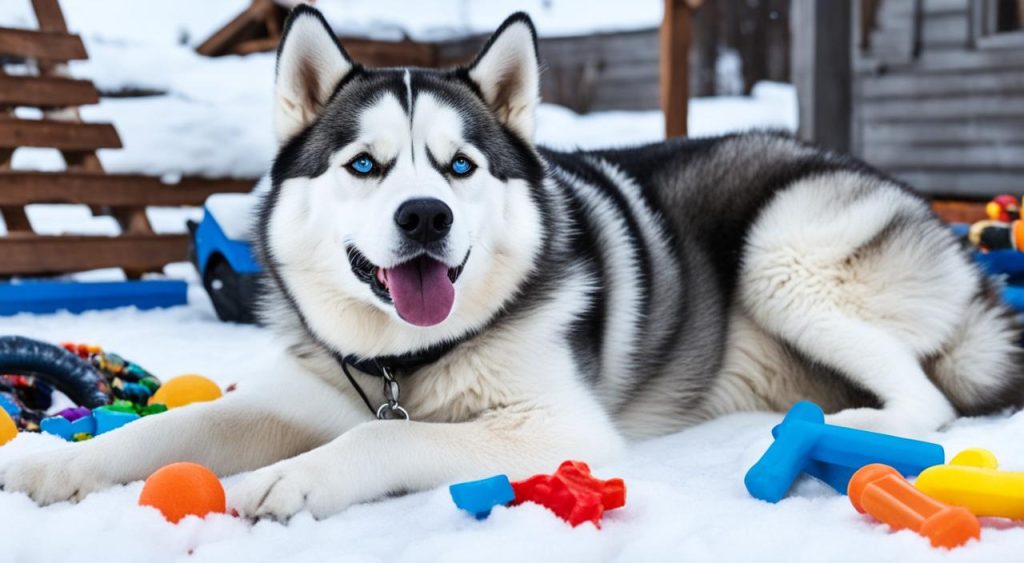When it comes to huskies, their vocalizations are a topic of fascination for many people. Videos of huskies appearing to imitate human speech have gained widespread attention on platforms like YouTube and TikTok. These vocal and expressive dogs use a range of sounds, from whines and screams to howls and yelps, which some people interpret as akin to “talking.” But is this just perception or can huskies actually mimic human speech? Let’s delve into the intriguing world of canine vocal mimicry and explore the unique talking ability of huskies.
Key Takeaways:
- Huskies’ vocalizations have fascinated people, leading to videos of them appearing to imitate human speech.
- Huskies use a variety of sounds, such as whines, screams, howls, and yelps, which some interpret as “talking.”
- Whether huskies truly mimic human speech is a topic of exploration.
- Understanding canine vocal mimicry can help us appreciate the communication abilities of huskies.
- Exploring the genetic and evolutionary factors behind huskies’ vocalizations can shed light on their unique talking ability.
How Do Huskies Communicate?
Huskies are known for their communicative nature and use vocalizations as a primary means of communication. They have an intricate system of husky communication, employing various tonal patterns to convey specific messages to their pack, which includes other huskies and their human family.
These tonal patterns are essential for husky pack communication, allowing them to coordinate their movements, whether it be signaling a change in speed or direction during a sled run or calling out to their pack in the wild.
One fascinating aspect of husky vocalizations is their ability to carry over long distances. This long-distance communication enables huskies to effectively communicate with each other even when they are far apart.
Huskies have a remarkable sense of hearing, which contributes to their ability to communicate through vocalizations. They can react to external sounds, such as sirens, crying babies, or music, and may even sing along to certain tunes.
Huskies may howl when left alone, expressing their anxiety or calling for their pack to return. Their vocalizations also serve as a way to express a range of emotions, from excitement and happiness to frustration and defiance.
Their vocal communication is not limited to howling alone. Huskies also use barks, whines, and other tonal variations to express their needs and desires.
Their vocalizations are an integral part of their communication repertoire, allowing them to establish social bonds, seek attention, and convey their emotions effectively.
Why Do Huskies Talk?
Communication plays a crucial role in the lives of huskies. It helps them establish and maintain social interaction and bonding, both with their human companions and other dogs. Through their vocalizations, huskies are able to convey their needs, emotions, and desires, creating a strong connection with their owners.
Importance of Communication for Huskies
Huskies use vocal communication to alert and warn their owners of potential dangers, which is particularly important when it comes to protecting their pack and territory. By expressing themselves through different types of vocalizations, huskies seek attention and engagement from their owners, ensuring that their needs are met and they receive the necessary care and affection.
Social Interaction and Bonding
Communication is a key component in establishing and maintaining social interaction and bonding between huskies and their human companions. Through their vocalizations, huskies express their desire for companionship and affection, fostering a strong emotional connection and deepening the bond with their owners.
Genetic and Evolutionary Factors
The vocal nature of huskies is deeply rooted in their genetic and evolutionary history. As descendants of wolves, huskies have inherited their ancestors’ communication abilities. This genetic predisposition allows them to use a variety of vocalizations, such as howling, barking, whining, and even a unique ability to imitate human speech, known as talking or singing.
Types of Vocalizations in Huskies
Huskies have developed various types of vocalizations to convey their needs and emotions. Howling is a characteristic vocalization that serves as a long-distance communication method, allowing huskies to communicate with their pack members even when they are separated. Barking is often used as an alert or warning signal, signaling potential danger or intruders. Whining is a way for huskies to express their frustration or seek attention. Additionally, huskies have a unique ability to imitate human speech, whether it’s mimicking certain words or singing along to music.
Conclusion
Huskies are known for their vocal abilities and their expressive nature when it comes to communication. Their wide range of sounds allows them to effectively convey their needs and emotions to both their pack and their human family. While they may not possess the ability to mimic human speech like humans do, huskies do have the capacity to imitate certain words and phrases, especially when regularly exposed to them.
This vocal mimicry is a result of genetic and evolutionary factors that have shaped the communication abilities of huskies. Their instinctual need for social interaction and bonding further enhances their talking ability. Whether it’s through howling, barking, whining, or their unique talking and singing sounds, huskies have a remarkable talent for expressing themselves through vocalizations.
Understanding and appreciating the unique vocal abilities of huskies can strengthen the bond between huskies and their owners. By recognizing the importance of canine communication and their need for social interaction, we can foster a deeper connection with these remarkable dogs. So, when your husky talks to you, remember that it’s their way of reaching out and expressing their emotions, proving once again that dogs truly are our faithful companions.





